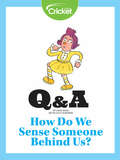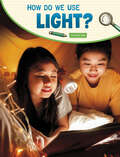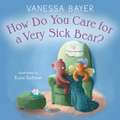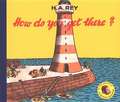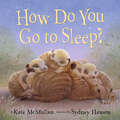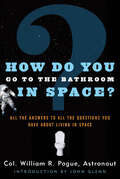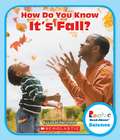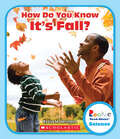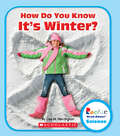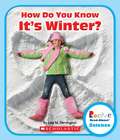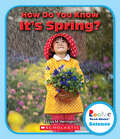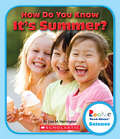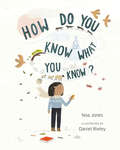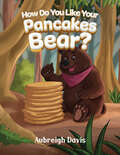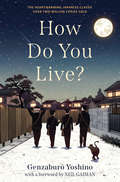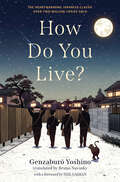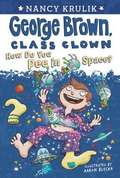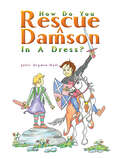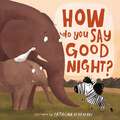- Table View
- List View
How Do We Sense Someone Behind Us?
by Lizzie WadeHow do humans sense when someone is behind them? This Q & A explains the science of peripheral vision.
How Do We Use Light? (Science Inquiry)
by Emily RaijLight is all around us. What is light? Where does it come from? How does it help us see? Readers investigate and read straightforward text accompanied by vibrant photos to learn all about light.
How Do You Care for a Very Sick Bear?
by Vanessa BayerFrom debut children's author Vanessa Bayer and illustrator Rosie Butcher, How Do You Care for a Very Sick Bear? is a sweet picture book with advice for children—and adults—for dealing with a sick friend.You and your friend Bearare an excellent pair.But if your friend gets sick, And can’t do all the things that you two love to do…You may wonder--how do you care for a very sick Bear?When someone dear is dealing with illness, it's difficult to know what to do or say. The actor Vanessa Bayer experienced this firsthand when she was treated for childhood leukemia. In her first children's book, she offers gentle, reassuring advice that people of all ages will appreciate.
How Do You Get There?
by H. A. ReyIn How Do You Get There? children guess the means of transportation to be used.
How Do You Go to Sleep?
by Kate McMullanDiscover how different animals go to sleep in this rhyming picture book from a veteran children's author! Follow along as three children learn about the bedtime routines of squirrels, parrots, dolphins, and many more. Meerkats sleep in a stack. Is that how these kids go to sleep? Or do they hibernate in snow all winter long like frogs? Or maybe they sleep the day away like skunks? No, that can't be right! By the book's conclusion, the kids have imitated all kinds of animals who are portrayed sleeping in their natural habitats, thanks to Sydney Hanson's charming illustrations. Readers will recognize the way the human child eventually goes to sleep--with stuffed animals, a bedtime story, and a kiss good night!A Bank Street Best Book of the Year "Punctuated with zaniness, McMullan's litany nevertheless offers a quiet, calming rhythm to help little ones nod off."--Kirkus"A bedtime book that will soothe and please children and caregivers."--SLJ"A nice pairing with Diane Muldrow's How Do Giraffes Take Naps?, Vin Vogel's Bedtime for Yeti, or Cari Best&’s I&’m Brave! I&’m Strong! I&’m Five!, particularly for little ones looking for comfort around sleeping in their own beds."--Booklist
How Do You Go to the Bathroom in Space?: All the Answers to All the Questions You Have About Living in Space
by William R. PogueHave you ever wondered what it's really like for an astronaut in outer space? From the exciting moments to the day-to-day details, from the serious to the humorous, you'll find answers to every question you've ever had about living in space!What does it feel like to be weightless? Would a sneeze propel you backward? What happens to your body in space? And, most importantly, how do you go to the bathroom in space?Find out the answers from the astronaut who for more than a decade held the world record for the number of days spent living in space!To take advantage of the renewed interest in space travel, thanks to the success of Packing for Mars, this re-release of the bestseller (with over a quarter million copies in print) features a fresh look, dozens of authentic NASA photographs, and an introduction by John Glenn.At the Publisher's request, this title is being sold without Digital Rights Management Software (DRM) applied.
How Do You Know It's Fall?
by Lisa M. HerringtonThese charming science books, written for the youngest readers, will teach children how to read the cues from nature and be able to differentiate one season to the next. Simple hands-on experiments that introduce young readers to everyday science Fun activities that allow young scientists to make observations about the world around them Fast facts - offering fun, sometimes little known facts about the subject Low, accessible reading level for emergent and struggling readers Glossary with pictures provides a visual review of important vocabulary terms Additional content for further learning on this subject available at www. factsfornow. scholastic. com
How Do You Know It's Fall? (Rookie Read-About Science: Seasons)
by Lisa M. HerringtonHow do you know its fall?Through vivid photos and engaging nonfiction text, this fun and fact-filled Rookie Read-About Science book answers the question, How do you know its fall? Covering everything from weather patterns to animal behaviors to seasonal activities, How Do You Know Its Fall? gives readers (Ages 6-7) an in-depth look at this season of change.
How Do You Know It's Spring?
by Allan FowlerHow do you know it's spring? When leaves begin to grow on the trees... when the grass turns green again... when the first flowers bloom in your garden or in the park, then you know it's springtime!
How Do You Know It's Winter (Rookie Read-About Science: Seasons)
by Lisa M. HerringtonHow Do You Know It's Winter?Through vivid photos and engaging nonfiction text, this fun and fact-filled Rookie Read-About Science book answers the question, How do you know its winter? Covering everything from weather patterns to animal behaviors to seasonal activities, How Do You Know Its Winter? gives readers (Ages 6-7) an in-depth look at this snowy season.
How Do You Know It's Winter?
by Lisa M. HerringtonThese charming science books, written for the youngest readers, will teach children how to read the cues from nature and be able to differentiate one season to the next. Simple hands-on experiments that introduce young readers to everyday science Fun activities that allow young scientists to make observations about the world around them Fast facts - offering fun, sometimes little known facts about the subject Low, accessible reading level for emergent and struggling readers Glossary with pictures provides a visual review of important vocabulary terms Additional content for further learning on this subject available at www. factsfornow. scholastic. com
How Do You Know It's Winter? (Into Reading, Read Aloud Module 5 #2)
by Ruth OwenNIMAC-sourced textbook
How Do You Know What Time It Is?
by Robert E WellsWhat would life be like with no clocks and no calendars? How would you know when to get up in the morning? How would you know when baseball season was about to start? Long, long ago, all people could do was watch the sun and moon and try to figure things out. Eventually, they made simple clocks like sundials. And as time marched on, people came up with more ways to measure it. Today, quartz crystal watches and atomic clocks tell us EXACTLY what time it is, at any moment, all over the world.
How Do You Know What You Know?
by Noa JonesA charming and inquisitive story that celebrates tracing the origin of ideas, language, and every day objects, for children 4–8.Where does snow come from? What language did the word thermos come from? And who was the Buddha's teacher?So many problems in the world come from accepting information at face value without looking into where it comes from. How Do You Know What You Know? follows a child and their father on a cozy, snowy day outing. The child asks questions about how things came to be the way they are. The questions range from how the father knows how to tie a shoe to why it&’s not a good idea to eat yellow snow. These queries are met by the father with patience and humor that weave a delightful narrative of intergenerational knowledge sharing. In this exchange, respectful inquiry is beautifully modeled for young learners.The journey includes an amble in the park, a trip to the library, a bus ride, and a visit to a local Buddhist temple where the father is a student. The teacher there introduces the child to the idea of lineage, that wisdom and understanding comes from generations of knowledge passed down from person to person. With a quaint and welcoming simplicity, the illustrations bring this beautiful story to life, and every spread has a subtle nod to the progression of how things come to be the way they are. The story encourages children&’s natural curiosity and shows them that everywhere they look there is a story to be told if we just ask.
How Do You Lift a Lion?
by Robert E WellsExplore the functions of levers, wheels, and pulleys, and learn how to lift a lion, pull a panda, and deliver a basket of bananas to a baboon birthday party!
How Do You Like Your Pancakes, Bear?
by Aubreigh DavisAn engaging and sometimes wacky journey, How Do You Like Your Pancakes, Bear? takes little readers on a ride through the animal kingdom and explores all of the different ways our furry friends prefer their favorite breakfast staple. From coastal waters to lush jungles, all the way to your own backyard, How Do You Like Your Pancakes, Bear? is sure to be a fun-filled journey for all to enjoy.
How Do You Live?
by Genzaburo YoshinoAnime master Hayao Miyazaki's favorite childhood book and a beloved Japanese classic, this uplifting coming-of-age story brings philosophy, history and wonder together, available in English for the first time.The streets of Tokyo swarm below fifteen-year-old Copper as he gazes out into the city of his childhood. Struck by the thought of the infinite people whose lives play out alongside his own, he begins to wonder, how do you live? Considering life's biggest questions for the first time after the death of his father, Copper turns to his dear uncle for heart-warming wisdom. As the old man guides the boy on a journey of philosophical discovery, a timeless tale unfolds, offering a poignant reflection on what it means to be human. But when Copper betrays one of his new friends, how will he ask for forgiveness — and how can he forgive himself? How Do You Live? is the inspiring, transformative story of a young man who, like his namesake Copernicus, looks to the stars and uses his discoveries to answer the question of what kind of person he will grow up to be.
How Do You Live?
by Genzaburo YoshinoThe first English translation of the classic Japanese novel, a childhood favorite of anime master Hayao Miyazaki (Spirited Away, My Neighbor Totoro, Howl’s Moving Castle), with an introduction by Neil Gaiman. <p><p> First published in 1937, Genzaburō Yoshino’s How Do You Live? has long been acknowledged in Japan as a crossover classic for young readers. Academy Award–winning animator Hayao Miyazaki has called it his favorite childhood book and announced plans to emerge from retirement to make it the basis of a final film. <p><p> How Do You Live? is narrated in two voices. The first belongs to Copper, fifteen, who after the death of his father must confront inevitable and enormous change, including his own betrayal of his best friend. In between episodes of Copper’s emerging story, his uncle writes to him in a journal, sharing knowledge and offering advice on life’s big questions as Copper begins to encounter them. Over the course of the story, Copper, like his namesake Copernicus, looks to the stars, and uses his discoveries about the heavens, earth, and human nature to answer the question of how he will live. <p><p> This first-ever English-language translation of a Japanese classic about finding one’s place in a world both infinitely large and unimaginably small is perfect for readers of philosophical fiction like The Alchemist and The Little Prince, as well as Miyazaki fans eager to understand one of his most important influences.
How Do You Lose Those Ninth Grade Blues?
by Barthe DeclementsWill Elsie be able to accept her (beautiful!) new self? Elsie Edwards, star of Nothing's Fair in Fifth Grade, is back! She's a whole lot thinner, but not much happier. Sure, she's got a lot of friends now; and she's going out with Craddoc, one of the cutest guys in the whole high school. But even though Elsie looks like "a thin Dolly Parton," she still can't quite believe that Craddoc really likes her. Her insecurity threatens to ruin their relationship. To make matters worse, Elsie's mother just won't realize that Elsie's growing up and doesn't need to be watched over all the time. It all adds up to make ninth grade a lot more trouble than Elsie had counted on.
How Do You Pee in Space? #13
by Nancy Krulik Aaron BlechaA real-life astronaut is coming to Edith B. Sugarman Elementary School, and one lucky kid gets to interview him! Not only that, a trip to a space adventurer program is also up for grabs. To win the contest, students must complete a physical fitness challenge and come up with three interesting questions to ask the astronaut. As always, George intends to beat his rival, Louie. But when the competition heats up, George is too distracted to notice how much the prize means to his best friend, Alex. For George, winning may not be everything this time around.
How Do You Raise a Raisin?
by Pam Muñoz Ryan"People have been gobbling up this yummy nutritious treat for centuries. Ancient Greeks and Romans awarded raisins at sporting events. Astronauts have been taking raisins into space. Take a peek inside this tasty book-you'll find out how grapes become raisins, who introduced the seedless grapes, and the many uses for raisins besides snacks!" In between the facts about raisins, children will delight in the silly poems about raisins. This file should make an excellent embossed braille copy.
How Do You Rescue a Damson in a Dress?
by Julie Dryden-HallEmbark on a whimsical tale of curiosity, adventure, sibling camaraderie, and a sprinkle of delightful misinterpretation in How Do You Rescue a Damson In A Dress? With eyes sparkling with wonder and a heart buoyed by courage, our young prince gallantly trails behind his elder brother, embarking on what he believes to be a noble quest to rescue a ‘Damson in a Dress.’ Unbeknownst to him, his brother is on a mission to save a Damsel in Distress. Armed with a valiant sword, a stash of sweets, and a flask of milk to quench his thirst, the young prince steps into a world brimming with enchanting adventures yet perilous encounters. His path intertwines with a formidable grizzly bear, a cunning and greedy wolf, a menacing crocodile, and the mythical Nessy Monster. Despite the lurking dangers, his youthful bravado never wavers. As the veil of misinterpretation humorously unfolds, will our young hero find the ‘Damson’ he seeks? Or will he discover a greater understanding of his brother’s true quest?
How Do You Say Good Night?
by Thomas NelsonA fun, new bedtime story to read to your kids!Join Zoey the zebra as she searches across Africa for the best way to say good night. She sees the bedtime routine of lions, warthogs, monkeys, and more—but which one is the very best?Teaching little ones to celebrate differences while appreciating the blessing of their own unique family, How Do You Say Good Night? is a great way to introduce the concept of diversity in a fun and respectful way while also fostering an attitude of gratitude.Watch your little ones reach for this book night after night!
